Last Updated on 11/04/2020 by Desmond
Green tea is well-known as a natural health beverage. Like the other true tea, it also made from the Camellia Sinensis. And they were classified into different types according to the different processing methods. Green tea processing is the only one without the fermentation step, the appearance, and the infusion retain the green color, that’s why it called green tea.
As the birthplace of green tea, China has the most yield so far. Green tea still being processing in the most traditional handwork. The veteran tea masters would judge the leaves’ state through the variation of touch, smell, and appearance during processing, in order to produce the highest quality.
Now let’s see how to process green tea in traditional Chinese ways.
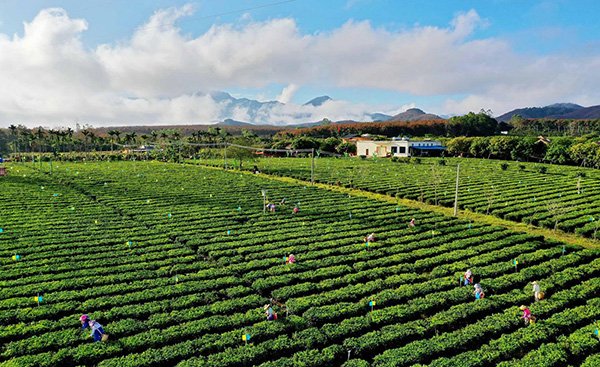
CONTENT
Picking
Picking is the first step, and it determines the grade of the products. The leaves for making green tea must choose the bud, first leaf, and second leaf on the same stem. The more tender the leaves, the high quality will be.
There are strict rules for picking. The size, fresh degree, and thickness should be almost the same; the sick, broken ones should not be selected. The picking typically starts at noon, the temperature is high, and the air humidity is low at that time. Collect the leaves in a basket; the dry and ventilated environment can prevent it from fermented prematurely. Foggy day or after rain is not a good time for picking.
Besides, which is more important is the picking seasons. Traditionally, spring is the best, the new buds just grew, and most of the high-quality green tea also made from the leaves picked in spring. The famous one is Mingqian Longjing Tea, which made from the leaves picked a few days before Qingming(a Chinese solar terms, usually at April 5.) Autumn also is a good picking season; the plants grow well after moisten of summer sunshine and rain.
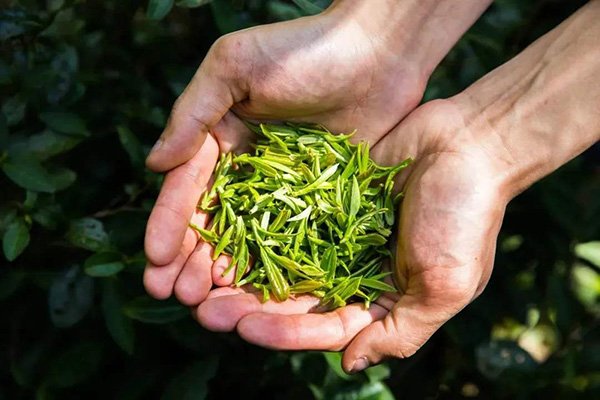
Placing
In some green tea producing regions, leaves will be placed for a while after picking, but not all green tea types need to do this.
The fresh leaves would not die at once after picked; they still alife for a while. The photosynthesis would stop because of the moisture and nutrient delivery breakdown, but the respiration still works. The moisture keeps flows to each part of the leaf until it devitalizes. And placing is for making the moisture get evaporation preliminarily, till 60%-70%, and make it become softer, easier for the following fixation job.
What is worth paying attention, in the white tea processing, there is a samely step call withering. The difference between them is how much time they cost. Withering typically spent several days, and it is doing outdoor; Placing cost only hours and must doing in the dark, air indoor. Once placing too long, the leaves will begin ferment, which is green tea does not need.
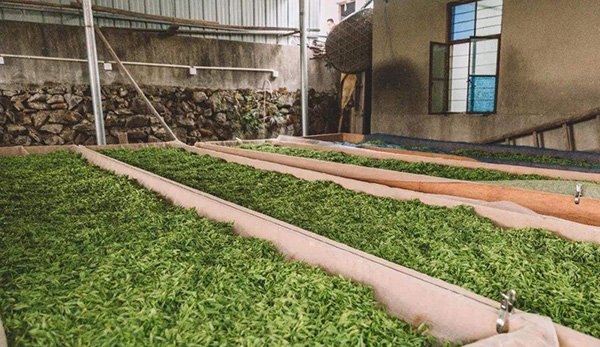
Fixation
Fixation is the key to green tea processing. The purpose of fixation is to inhibit the activity of oxidase in leaf by high temperature, thus preventing it from fermentation, and further reduce the moisture content. And the high temperature also takes some change to the ingredients, for making the satisfactory products.
The temperature and timing should be controlled well during fixation, it’s important. If heating too long time, it may increase the fermentation speed; the excessively high temperature may make the leaves burnt and reduce the quality. So it relies on the experience of tea masters much.
According to the different methods of fixation, it mainly classified into stir fixation and steaming.

Stir Fixation
Stir fixation means to stir and fries the tea leaves in a pan to fixation. Most of the Chinese green tea was being processed in this way.
The tea masters heating the pan to a high temperature and putting moderate fresh leaves in, then stir-fry quickly, made the temperature of them increase rapidly to destroy the activity of oxidase. After that, reduce the heat of the pan, prevent the leaves from burnt.
The stir fixation job also can be done by a machine, but to the high-class green tea, it still needs to done by the tea master in hand way. Yes, they use their hands to fry but not with the spatula. How many leaves should put one time, how long frying, what temperature is suitable, all these things rely on the experience of the tea masters.
After the stir fixation, the tea leaves will turn into a little dark green, flexible, and lost most of the plant smell.
Steaming
Steaming is the most primitive tea fixation way; it is much antique than stir fixation. The tea masters put the fresh leaves into a steaming cage, use the water steam to heat the leaves quickly, and achieve the purpose of fixation.
Due to the different heating methods, steaming green tea retains more natural ingredients and chlorophyll than stir fixation green tea. So the appearance and infusion of steaming green tea still fresh colors. Relatively, the fragrance of steaming green tea is not as well as the stir fixation, and more plant smell left behind.
Steaming green tea was spread from China to Japan in the Tang Dynasty (618-907.) Till today, most of the Japanese green tea still processed in a steaming way; the famous one is Gyokuro.
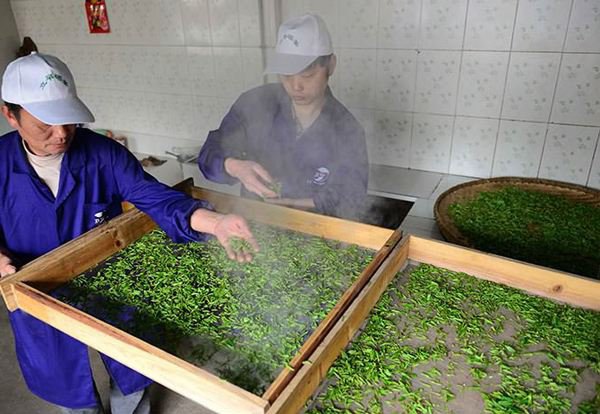
Rolling
After fixation, the leaves become soft, rub them with fingers can feel sticky. Placing them for a while for cooling down, tea masters will do the next job – rolling. Although some rarer green tea does not require rolling, it is a necessary step to other types.
There are 2 aims of rolling:
- To shape the leaves. According to different types of green teas, roll the leaves into the strip, needle, or spheroidal, and reduce their volume;
- To break the tissue of the leaves suitably, let the juice outflow a little on the surface. That helps to dissolve more taste into the water when brewing later.
Similarly, most of the rolling jobs will be done by a particular machine, except for some high-grade green tea that will be done by hand.
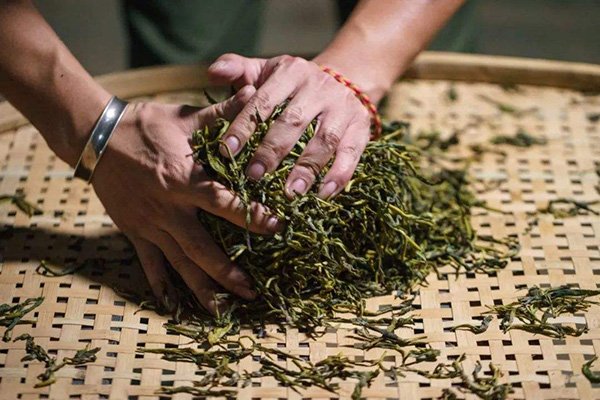
Drying
Drying is the last step of green tea processing, also determines the quality of the products. There are 3 purposes of drying:
- Evaporate the moisture further;
- Promote the further transformation of the tea leaves ingredients, to form unique flavor;
- Make the leaves more compact on the based of rolling forming;
Different drying methods can be subdivided into stir-fixation green tea, hot-air fixation green tea, and sun-fixation green tea.
Stir-fixation Green Tea
Just like the stir fixation, put the leaves into a pan and fry again. This time it will take longer to let more moisture evaporate and get a more compact body. The tea master keeps stir and frying the leaves to get the ideal moisture content. The most famous stir-fixation green tea is Longjing, Biluochun, and Xinyang Maojian.
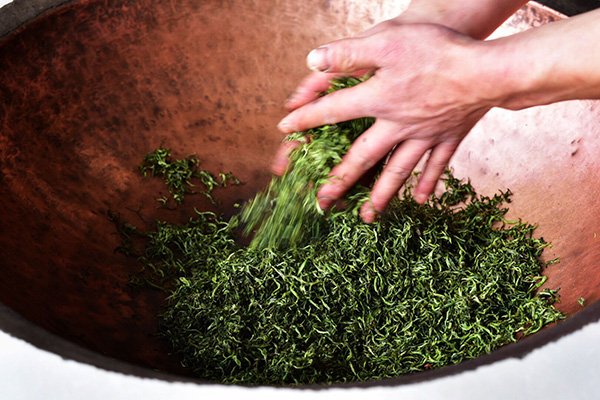
Hot-air Fixation Green Tea
Drying the leaves with hot-air. In tradition, tea master put the leaves on a bamboo sieve, with a charcoal stove below, let the rising hot-air to heat and dry the leaves. But nowadays, most of this job is done by a particular machine.
Most of the hot-air fixation green teas were taken as the basic-tea of the scented teas. Green tea after hot-air drying will get a strong adsorption capacity, tea masters scenting them with the dry flowers, to make the scented tea. The famous one is jasmine tea(Know more about jasmine tea). And to some special green tea, like Liuan Guapian, will be baked several times to dry; And the steaming green tea also drying in a hot-air way at the end.
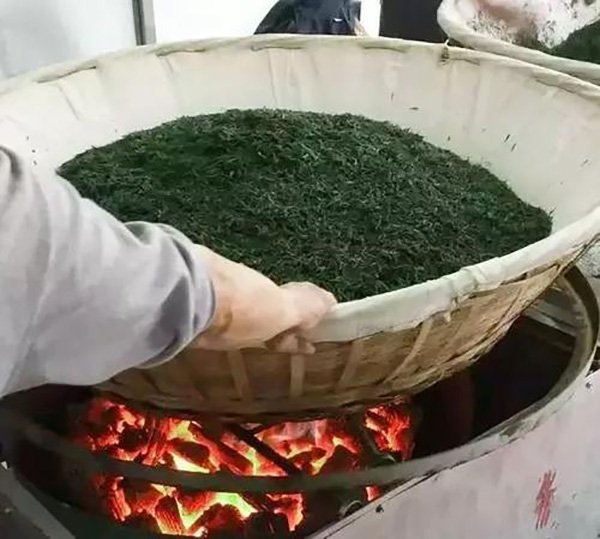
Sun-fixation Green Tea
Use the sunshine to dry the tea leaves directly; This method is widely used in Yunnan, China. Because of the temperature that the sunlight provided is low, to dry the leaves typically needs several days. During this time, due to without high-temperature heating, the moisture was natural evaporated, so more ingredient retained.
The sun-fixation green tea usually residue the herbaceous taste, even got the “sun smell.” And most time, the teas do not serve directly but taken as the basic-tea to make Tuo Cha and Pu-erh.
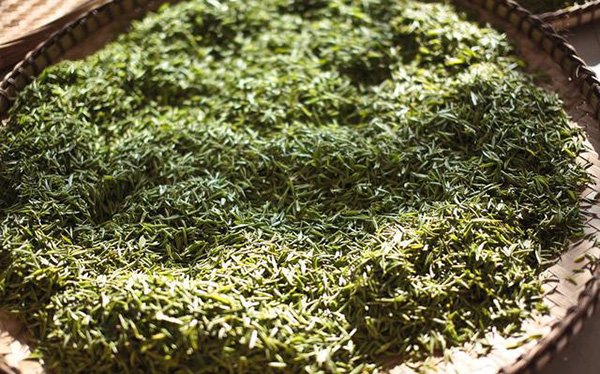
Refining
Most green teas were processing through the 3 steps above. To different types, some steps would be repeated. And to some rare products, they would be refining further.
Actually, the green tea refining is checking and screen the leaves pieces by pieces by hand. Filter out the broken leaves and the tea stem, then classific them according to size, to make each package product got the same quality. Tea masters also try the taste and discard the failed teas. Finally, only the best will pack for sale.